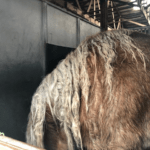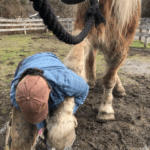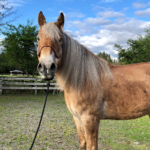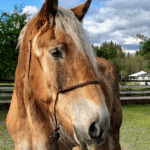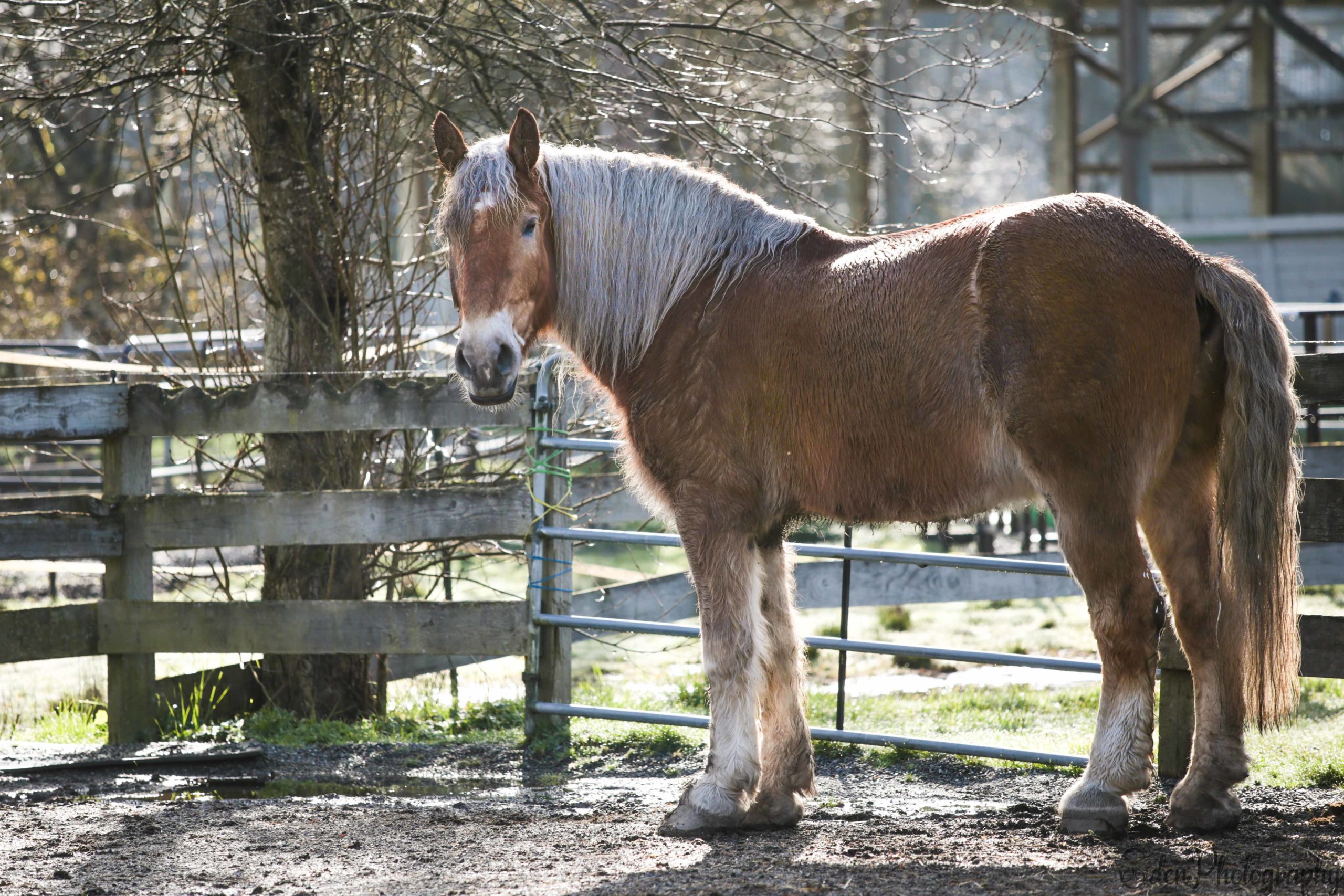Slim
2002 Belgian gelding
Registered Name: Slim Pickens
Type of Rescue: Owner Surrender
Intake Date: 3/5/2019
Adoption Date: 3/27/2020
Length of Time with SAFE: 1 year
Rest in Peace, dear Slim
Slim and his two herdmates were surrendered to SAFE after the sudden and unexpected death of their owner. The three horses had not received proper care for a while, and Slim in particular was underweight. His hooves were badly in need of trimming, and his flaxen mane was tied up in knots. We were told that Slim injured his back as a young horse, so he couldn’t carry a rider. He lived his life as a beloved family pet, and with his sweet and soulful nature, it was no wonder. Slim’s giant hooves could not carry his giant heart. What started as an abscess became an infection of his coffin bone and continually caused him different degrees of pain that we fought against for nearly 9 months. We spent hours doctoring and treating his hoof and he was given massive amount of antibiotics and painkillers to try and get ahead of his infection. Sadly, it was a losing battle. In the end, we had to lay down our swords and let our big-hearted friend go free.

Goodbye, Slim
It is hard to share sad news with you, knowing how difficult the world is right now. But unfortunately, some things can’t wait for this to pass. We have been struggling to keep Slim comfortable for over 9 months. What started as an abscess became an infection of his coffin bone and has continually caused him different degrees of pain. Vets from Rainland Farm Equine Clinic have been out countless times, We’ve spent hours doctoring and treating his hoof. He has been on a massive amount of antibiotics and painkillers to try and get ahead of this infection but unfortunately it has been a losing battle. It is time to lay down our swords and let our big-hearted friend go free.
Earlier this week, Slim’s comfort level took a turn for the worst. Dr. Lewis came out to SAFE to see him, and discovered that another abscess was brewing right next to the one we had been struggling to keep clean and close up. We were no longer able to keep him comfortable on the pain meds. To put him through another round of treatment — risking infection and keeping him in discomfort — just didn’t seem right or in the best interest of Slim. So we made the painful decision to let him go.
We have done absolutely right by Slim; he has lived a happy and safe life with us over the past year and every want has been fulfilled. Slim, Moon, and Cassidy were in a miserable situation when we found them. We should all feel joy in knowing that all their lives have been better because of our love. This final act of kindness is an enormous responsibility that we take on when we bring a horse into our lives. This decision is in no way something we take lightly. The staff has discussed, researched and weighed each choice carefully along the way.
Slim was peacefully laid to rest today. This gentle giant will live on in our hearts and our memories. As one of our volunteers said, it’s nice to imagine him crossing over and hitting the ground running with a beautiful new set of hooves. Rest in peace, dear Slim. We’ll miss you, big buddy.
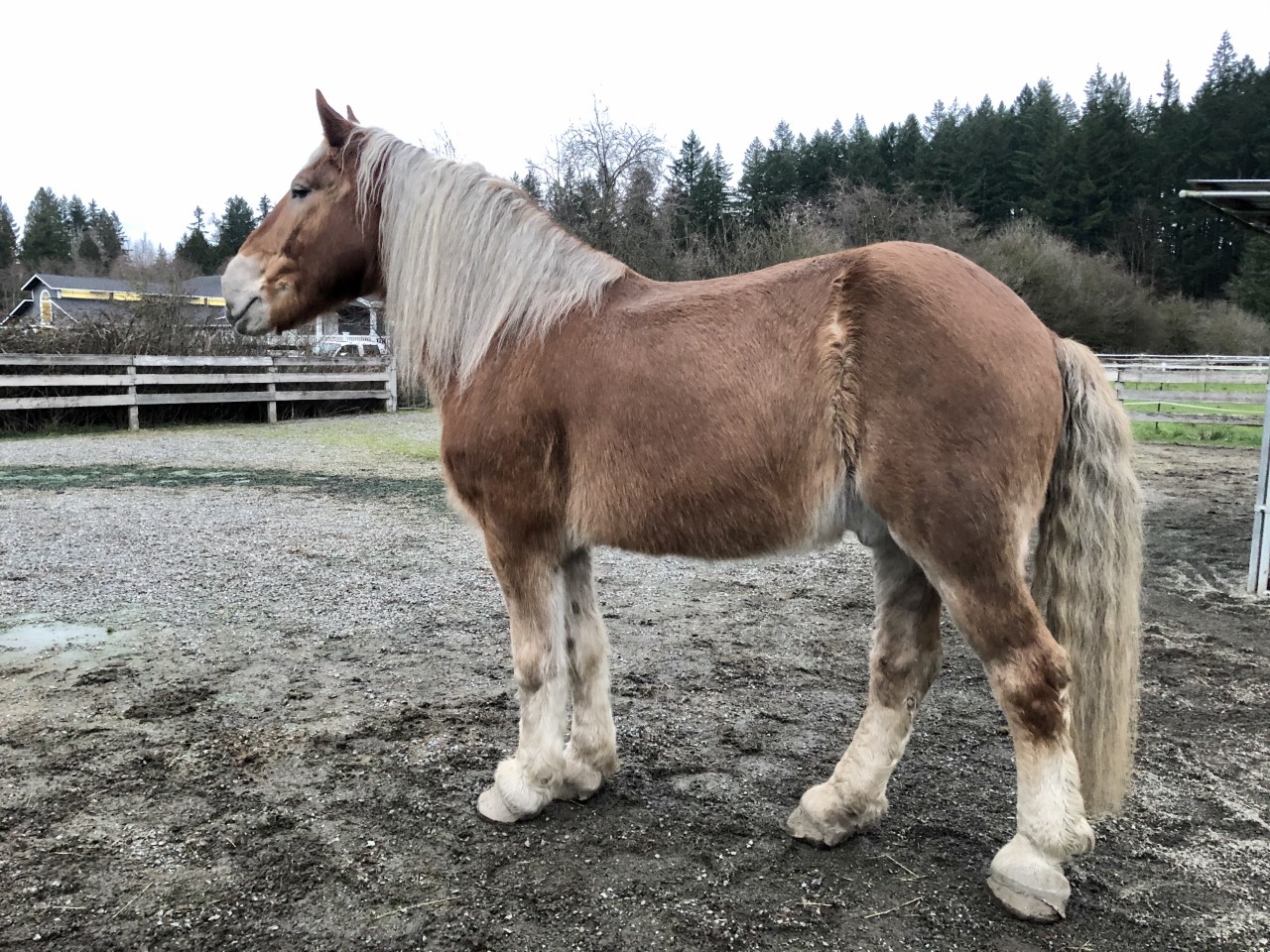
Slim’s Hoof: A Summary and Where We Are Today
We’ve been fighting a losing battle with Slim’s foot. Every time we think we’re making progress in getting him healed, another abscess pops up and the crack in his foot becomes even bigger. Because this has been going on for such a long time, let me summarize the chain of events that has gotten us where we are today.
We had suspected that Slim dealt with recurring issues in his left front foot since his arrival at SAFE due to the appearance of his hoof wall. Rather than a nice, smooth, wall, the front (dorsal) part of Slim’s hoof was littered with cracks and ridges. Evidence that there was a chronic problem there. But Slim remained trouble-free for the first few months we had him. Then July rolled around, and he became acutely painful in that foot. Radiographs revealed a large abscess brewing and osteomyelitis, an infection in his coffin joint. A few days of wrapping his hoof and applying icthammol ointment helped bring the abscess to the surface, and the largest abscess I’ve ever seen eventually busted through his coronary band.
Slim was placed on long-term antibiotics and pain meds for the osteomyelitis. His foot was re-wrapped first daily to help draw the drainage out, and then we eventually got to phase out the bandages once things dried up. But it seemed like every time one abscess would clear, another would pop up in its place. He still remained on the antibiotics, and we played with the pain medication levels depending on what Slim would tell us. Some days he’d be as comfortable as could be so we’d back off the pain meds thinking we were making progress, but other days he’d start to limp again with another abscess brewing so we’d increase the meds a little. In October, Dr. Fleck came out to dremel a hole in Slim’s hoof wall to allow for more drainage. Once this hole was placed, Slim seemed much more comfortable. We were hopeful that this was going to be the answer to our problem. But alas, it was only a temporary solution.
Throughout all of this, a crack began to form. It started at the bottom of his foot where it meets the ground and slowly traveled upward. Eventually the abscesses near the coronary band started a crack up in that region that slowly traveled downward. All the cracking met at the middle at the dremeled hole to create one solid crack that spans the entire length of his hoof.
From the beginning of this whole foot dilemma, our vets at Rainland Farm Equine laid out our options in black and white. We could do surgery. Surgical debridement of the coffin bone to remove the infected area is a standard treatment for osteomyelitis. This option was not a great one for Slim because a horse undergoing this surgery needs to be good with having their feet held up for an extended period of time during surgery. Slim is not amenable to holding his foot up for long at all, even under sedation. They could lay him down under general anesthesia to do the surgery, but general anesthesia in draft horses is quite risky, not to mention expensive. We were told the other procedure to try would be putting a supportive shoe on him to keep the crack from being reinforced every time Slim takes a step. A shoe that holds the foot together would give it a chance to grow out normally. But again, Slim is not great for having his feet handled for lengthy periods of time, as would be required with shoeing. He would need to be sedated for each shoeing, and even then, there would be no guarantee that he’d allow us to get a shoe on in the first place. The only other option we had other than euthanasia was to try the conservative approach with medication and bandaging. This is the option we ended up taking.

Oftentimes, the conservative approach pays off and the horse recovers just fine without going to extreme measures. But this has not been the case with Slim. Medication and bandaging have improved the osteomyelitis a bit. His radiographs look better now than they did at the time of his last recheck in the fall. But it’s become clear that there’s no way this crack is going to heal without intervention.
And so, Slim had a group consult with Drs. Fleck and Lewis from Rainland Farm Equine Clinic and farrier, Lisa Fite. He was sedated, x‑rays were taken, another abscess was pared out of his sole, legs went flying, he was sedated again, and a special shoe was placed. It was a long endeavor but, with patience, Lisa was successful in getting the shoe on. We are now treating the solar defect daily with betadine until it heals, and we are continuing with the antibiotics and pain medication.

Slim’s new shoe!
We’ll have a recheck done on him in a couple of weeks. Hopefully at that time the vets will be able to see some progress. Everyone here is pulling for him, and he is definitely a favorite around the barn. He’s charismatic and loves attention, and it’s tough not to love that sweet, giant face. But we have to make sure that we’ll be able to keep him comfortable in the long run, because asking a horse to continue living life in pain isn’t fair–and it’s not what we’re about. Unfortunately if this treatment route doesn’t work, then we’re out of realistic options for him. An 1,800 pound draft horse needs sturdy feet to stand on. We haven’t given up hope, though. Stay tuned for a progress report in a couple of weeks.

Slim’s Hoof Saga Continues
Slim has been battling osteomyelitis in his coffin bone for a couple of months now. We thought we were seeing improvement but then he hit a snag with another recurring abscess just below his coronary band. No matter how much soaking and pouticing we did, the abscess just kept draining and Slim continued to be mildly lame on that leg even with pain medication on board. Dr. Fleck decided that he needed to dremel part of the hoof wall away to open it up and allow for more efficient drainage.
Dr. Fleck came out about a week ago, sedated Slim, and used his dremel tool to open up a hole about the size of a nickel. We were instructed to flush it generously with hydrogen peroxide, apply epsom salt poultice ointment to the hole, wrap, and repeat every few days until healed. We’re cautiously optimistic, but it seems like it might have done the trick. The abscess has now stopped draining and Slim’s lameness is gone. We’re hopeful that maybe we’re finally turning a corner with this foot.
For now, Slim will remain on the long-term antibiotic course that he was prescribed when this all began back in July. Hopefully this dremel procedure will keep him on the right track and we’ll get to discontinue the medications soon. But at the moment the future is still unclear. Thankfully, Slim is a patient guy and he doesn’t mind all the fuss. He really enjoys all the attention he gets with his twice daily medicating and frequent bandage changes!

Big Horse, Big Hoof: Slim’s Foot Problems
A 17.2 hh draft horse puts a lot of weight on his front feet. So it’s important that those feet stay healthy to help support the horse’s sheer mass. Unfortunately for our sweet Slim, hoof care has been a struggle. It’s unclear whether Slim’s hoof problems arise from a history of poor hoof care or if he’s just one of the unlucky ones prone to chronic hoof abscesses. We will never know for sure. But based on how grown out and cracked his feet were when he arrived at SAFE, it’s not surprising that he has issues. There’s evidence of prior abscesses along almost the entire length of his left front foot. So he has clearly been dealing with this trouble for at least a year, since that is about how long it takes an average horse to grow out their hoof wall from top to bottom.
A few weeks ago, Slim’s foster family called to say that Slim was non-weight bearing on his left front foot. Likely another hoof abscess. Our farriers, Daphne and Andrea, just happened to be a the barn that day so they were able to see Slim and bandage his hoof. Hoof abscesses are usually fairly straightforward to manage and we have enough experience with them that we can deal with most of them on our own, but Slim is not great about holding his feet up for any length of time. So having not one, but two farriers available to tag-team a giant hoof bandage application was incredibly helpful!
Slim seemed to do better that weekend while on phenylbutazone for pain. But when things seemed to worsen the following week, it was clear that this was not a typical abscess and our big Belgian needed veterinary attention. Slim spent many hours lying down, trying to take the weight off of his front foot. The abscess had still not burst, and the slight bump at the coronary band where it had looked like it would come through had grown substantially. Walking was agonizingly painful for him, so he did anything he could to avoid it. His water and food were brought to him in the pasture to minimize movement and pain. Dr. Lewis of Rainland Farm was the doctor on call that afternoon so she came out to examine him.
Dr. Lewis took radiographs of Slim’s foot to check for a draining tract from an abscess, evidence of laminitis, and any other hoof abnormalities. She found signs of osteomyelitis, which is a painful infection of the coffin bone. It also seemed that there might be a small solar abscess with a draining tract up into the coffin joint. A septic coffin joint would be very bad news for this big guy. Luckily, Dr. Lewis tapped the joint and in the process was able to rule that out as a possibility.
Slim’s foot was bandaged up again and he was placed on pain meds and long-term antibiotics to help heal the abscess and osteomyelitis. After another day or two the abscess finally burst through his coronary band, creating a large separation where it meets the hoof wall. Unfortunately, since he also has the pain from the osteomyelitis, the abscess rupturing didn’t offer a huge amount of pain relief like it normally does. So Slim remains on the pain medication for now.
It took about a week on the antibiotics to see much improvement, but Slim now moves a little more comfortably with each passing day. We have been keeping a close eye on things and watching for signs of supporting-limb laminitis in the opposite front foot, since he’s placing so much weight on that other leg while this left one heals. So far there no signs of this which is great news. His hoof bandage is getting changed every three days, and with each dressing change there is a little less drainage from the abscess.
Slim had us worried for a little while, but things are looking up. With continued antibiotics and pain medication, we hope he can make a full recovery. This foot is compromised from all of the prior abscesses, and it will take a year or more for evidence of them to disappear. It is possible that this might continue to be a long-term problem for him. But now that Slim is getting regular hoof care and proper nutrition since becoming a member of the SAFE herd, we hope that these hoof abscesses will become farther and fewer between.
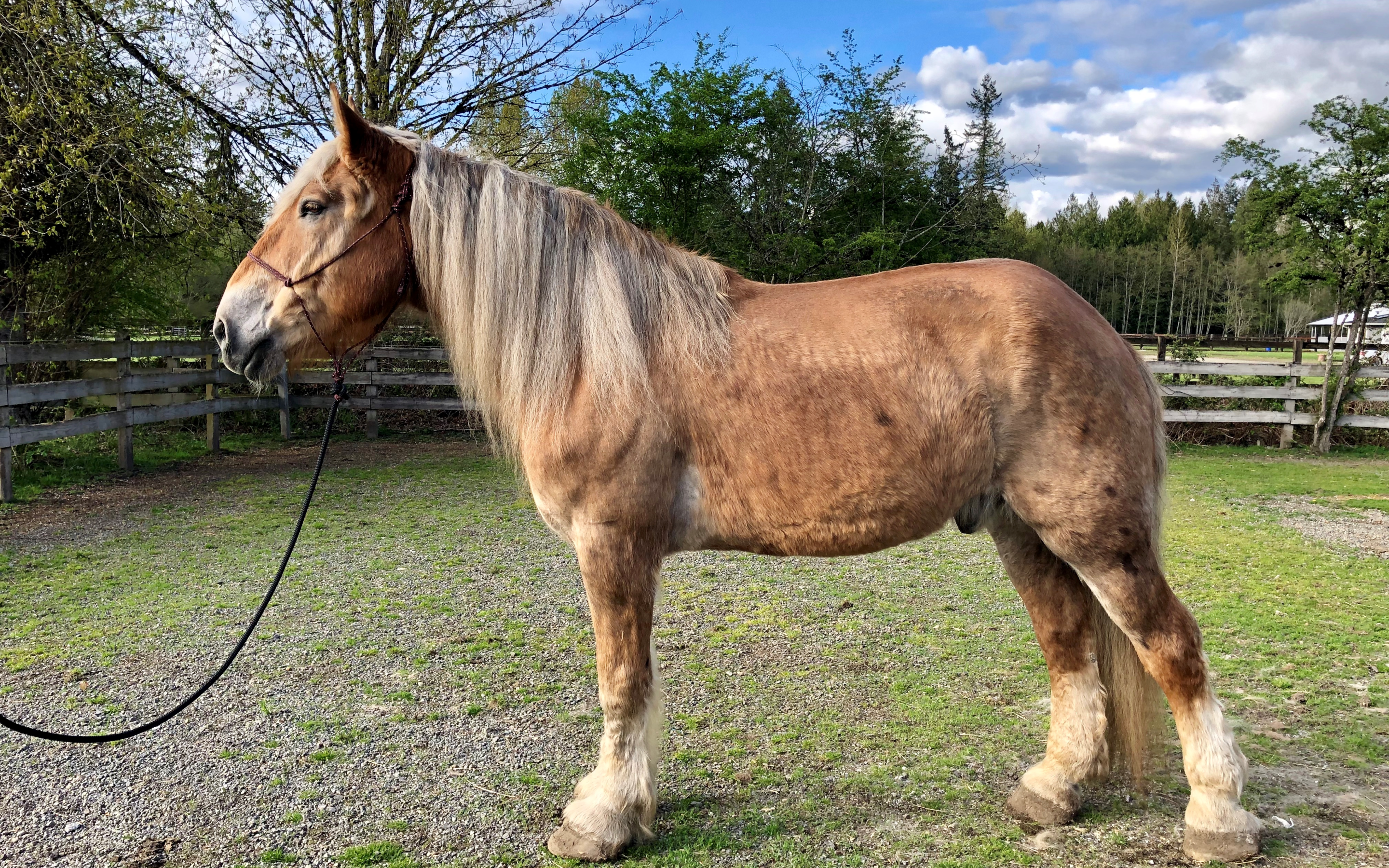
Slim’s Metamorphosis
It’s been a little over a month since we took in this handsome draft horse and his friends. Slim has been fun to get to know (spoiler alert: he’s pretty great). He came in underweight, scruffy, matted, and covered in rain rot. But with TLC and elbow grease, he’s blossoming into a beautiful Belgian.
Since arriving at SAFE, Slim has gained back most of the weight that he needed to be at a normal body condition score. His scruffy coat was deceiving at first and he didn’t look too thin at first glance, but underneath that winter coat were prominent ribs, spine, and hip bones. The rain rot that covered most of his back and rump is now a thing of the past, and his overgrown hooves look normal again.
Due to his size, grooming this guy is a huge task. It’s often a two person job! Slim’s unhealthy coat and rain rot scabs began falling out in clumps, and for a few weeks he had bare patches where the healthy coat was just starting to grow in. He looked kind of like a patchwork quilt. Daily currying has helped to speed the process along. Today, Slim is looking smooth and stunning. He has a little ways to go yet, but he’s almost there!
- Slim on the day we brought him home–he barely fit into the trailer!
- Slim’s dreadlocks on the day we brought him home
- Our trimmer, Daphne, getting Slim’s hooves back into shape
- The beginning of the patchwork quite phase
- The beginning of the patchwork quite phase
- New hair growing in along his topline
- Almost need a step stool
- Slim today
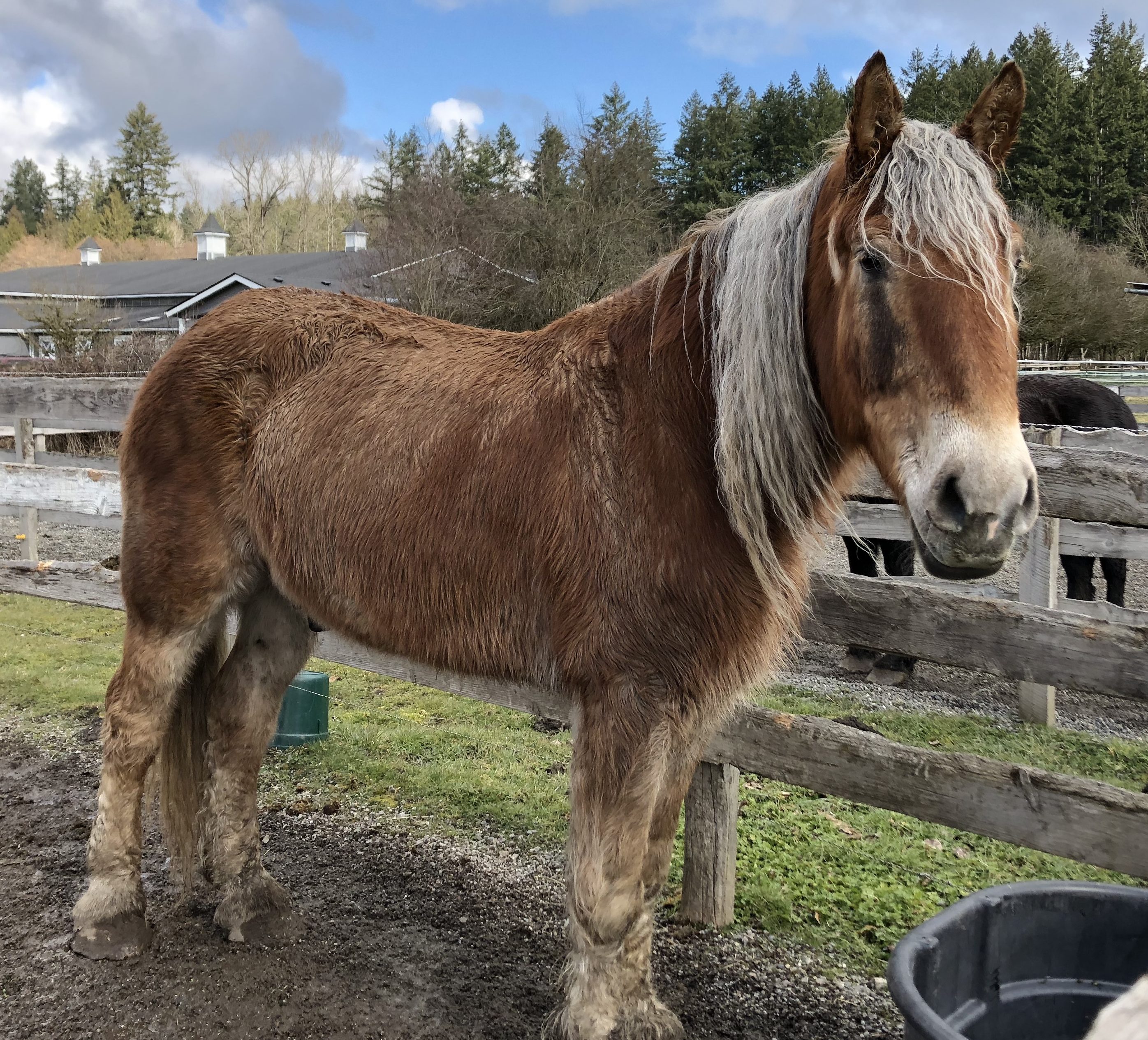
New Horses at SAFE
Slim, Moon, and Cassidy were surrendered to SAFE after the sudden and unexpected death of their owner. Their owner’s passing coincided with an unusually large amount of snowfall in this area, so friends and neighbors pulled together to take care of the horses until they could be transported to SAFE. The three horses have not received proper care for a while, and Slim, a 17 year old Belgian gelding, is underweight. His hooves are badly in need of trimming, and his flaxen mane is tied up in knots. The other two horses are Moon, a 17 year old Percheron mare, and Cassidy, an 11 year old Arabian mare. The two mares were in better shape, as they were dominant over the gelding, and often wouldn’t allow him to eat.
All three horses are very sweet and friendly, and have clearly been treated well. Slim reportedly suffered a back injury as a young horse, and cannot be ridden. We’re told that Moon has been ridden, and Cassidy, who was born on the property, had not been started.
After the snow cleared, we went to pick the horses up, and were quite surprised to see Slim in person. He is huge!! We’d already decided that he would be the first horse to load into our three-horse trailer, but once we got him into it, we realized that we weren’t going to be fitting anyone in there with him. He pretty much filled the space! So we hauled Slim home to SAFE, then went back the next morning to get Moon and Cassidy. All three horses hauled well, despite their inexperience with trailering.
The three horses are currently in quarantine, and are living outside 24/7. This allows us to avoid having anyone handling them any more than necessary. Slim, while a friendly and sweet fellow, has not been handled much, and because of his size, when he wants to go somewhere, there’s not a lot that can be done to stop him! But once he’s made a full recovery, we’ll be able to start his horsemanship training and teach him some new and better ways to interact with humans. The three horses seem to have settled in well.
Want to see the new horses in person? Mark your calendars for the SAFE Open House, coming up on Saturday, April 27 from noon to 3pm. Everyone is welcome! Come say hello to our new friends!
“before” photos:


